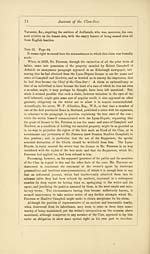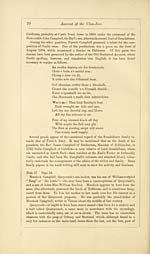Account of the Clan-Iver
(87) Page 73
Download files
Complete book:
Individual page:
Thumbnail gallery: Grid view | List view

Account of the Clan-Iver. 69
Bodaich-na-hriogais, " Bodies wi' the breeks," are descriptive of the Sinclairs,
who wore the low-country dre9s, their adversaries the Campbells and Maclvers
being clad in the Highland garb. Calder, in his History of Caithness, repre-
sents Finlay as a native of Perthshire. He was more probably the son of a
Finlay Maclver, who lived at Stainland.in the Parish of Thurso, and he continued
to reside in Caithness for a considerable time after the battle of Altimarlach.
although perhaps he may have removed to Perthshire ultimately, with Lord
Breadalbane. His Chief, Campbell of Quoycrook, seems to have shewn his sense
of the gallant piper's merit by becoming godfather, goisteadh, at -the baptism
of his son Alexander, in 1687. Among Calder's mistakes in regard to Finlay,
may be mentioned his ascribing to him the authorship of the " Campbells are
coming" and of " Failt Chlann-lmlieair." See below, Note 29.
Note 24. Page 34.
William Roy Campbell, or Maclver, is sometimes named, from his father,
MacFarquhar — in Gaelic MacFhearchair — whence he is called in some writings
MacKerchar and MacKyrchar. After the death of his uncle and father-in-law,
Quoycrook, and in the absence of his cousin, the Reverend Donald or Daniel
Campbell, he acted as the head of the Maclvers in Caithness. He was long
remembered for his genial disposition and profuse hospitality. It is related
that on one occasion the Chief of the Gunns, attended by the usual following,
paid William Roy a formal visit at Rumsdale. To bury the remembrance of
rencounters of a very different kind on the part of their forefathers, William
Roy, with the rude hospitality of the day, broached an ankur of brandy. After
three days spent in festivity, the whole party set out on foot to pay a visit to
Mackay of Bighouse, twenty miles distant, a gillie of William's carrying the
anker on his shoulder. On reaching the top ot Knocksletil, about hall way to
Bighouse, they stopped to refresh themselves, and the anker having been emptied,
William gave it a kick, on which it rolled to the foot of the hill, and kalf-a-mile
along the level. For this anecdote the writer is indebted to Captain Gunn of
Braehour, a descendant of the Chiefs of the Clan-Gunn in Caithness.
Note 25. Page 34.
Some of his relatives, Campbells from Perthshire, followed Glenorchy on his
first arrival in Caithness in 1669, and as he quartered some of his troops in
the county for three or four years after 1680, a few more Perthshire Campbells
may have remained behind. But almost all these are understood to have with-
drawn from Caithness when Glenorchy disposed of his property there.
There are also in Caithness some Campbells said to be descended from a
family which came into Caithness through Tongue, in Sutherland, about 130
years ago, and settled at Achavaras<lale, in the Caithness part of Reay, now the
property of Sir Robert Sinclair of Steveuston and Murkle.
I>ione of these are to be confounded with the Campbells of the Clau-Iver.
Note 26. Page 34.
Accounts still exist of payments to Patrick Campbell of Quoycrook. for
supplies purchased by him- for Breadalbane's troops, stationed in the west of
Bodaich-na-hriogais, " Bodies wi' the breeks," are descriptive of the Sinclairs,
who wore the low-country dre9s, their adversaries the Campbells and Maclvers
being clad in the Highland garb. Calder, in his History of Caithness, repre-
sents Finlay as a native of Perthshire. He was more probably the son of a
Finlay Maclver, who lived at Stainland.in the Parish of Thurso, and he continued
to reside in Caithness for a considerable time after the battle of Altimarlach.
although perhaps he may have removed to Perthshire ultimately, with Lord
Breadalbane. His Chief, Campbell of Quoycrook, seems to have shewn his sense
of the gallant piper's merit by becoming godfather, goisteadh, at -the baptism
of his son Alexander, in 1687. Among Calder's mistakes in regard to Finlay,
may be mentioned his ascribing to him the authorship of the " Campbells are
coming" and of " Failt Chlann-lmlieair." See below, Note 29.
Note 24. Page 34.
William Roy Campbell, or Maclver, is sometimes named, from his father,
MacFarquhar — in Gaelic MacFhearchair — whence he is called in some writings
MacKerchar and MacKyrchar. After the death of his uncle and father-in-law,
Quoycrook, and in the absence of his cousin, the Reverend Donald or Daniel
Campbell, he acted as the head of the Maclvers in Caithness. He was long
remembered for his genial disposition and profuse hospitality. It is related
that on one occasion the Chief of the Gunns, attended by the usual following,
paid William Roy a formal visit at Rumsdale. To bury the remembrance of
rencounters of a very different kind on the part of their forefathers, William
Roy, with the rude hospitality of the day, broached an ankur of brandy. After
three days spent in festivity, the whole party set out on foot to pay a visit to
Mackay of Bighouse, twenty miles distant, a gillie of William's carrying the
anker on his shoulder. On reaching the top ot Knocksletil, about hall way to
Bighouse, they stopped to refresh themselves, and the anker having been emptied,
William gave it a kick, on which it rolled to the foot of the hill, and kalf-a-mile
along the level. For this anecdote the writer is indebted to Captain Gunn of
Braehour, a descendant of the Chiefs of the Clan-Gunn in Caithness.
Note 25. Page 34.
Some of his relatives, Campbells from Perthshire, followed Glenorchy on his
first arrival in Caithness in 1669, and as he quartered some of his troops in
the county for three or four years after 1680, a few more Perthshire Campbells
may have remained behind. But almost all these are understood to have with-
drawn from Caithness when Glenorchy disposed of his property there.
There are also in Caithness some Campbells said to be descended from a
family which came into Caithness through Tongue, in Sutherland, about 130
years ago, and settled at Achavaras<lale, in the Caithness part of Reay, now the
property of Sir Robert Sinclair of Steveuston and Murkle.
I>ione of these are to be confounded with the Campbells of the Clau-Iver.
Note 26. Page 34.
Accounts still exist of payments to Patrick Campbell of Quoycrook. for
supplies purchased by him- for Breadalbane's troops, stationed in the west of
Set display mode to:
![]() Universal Viewer |
Universal Viewer | ![]() Mirador |
Large image | Transcription
Mirador |
Large image | Transcription
Images and transcriptions on this page, including medium image downloads, may be used under the Creative Commons Attribution 4.0 International Licence unless otherwise stated. ![]()
| Histories of Scottish families > Account of the Clan-Iver > (87) Page 73 |
|---|
| Permanent URL | https://digital.nls.uk/95352911 |
|---|
| Description | A selection of almost 400 printed items relating to the history of Scottish families, mostly dating from the 19th and early 20th centuries. Includes memoirs, genealogies and clan histories, with a few produced by emigrant families. The earliest family history goes back to AD 916. |
|---|

